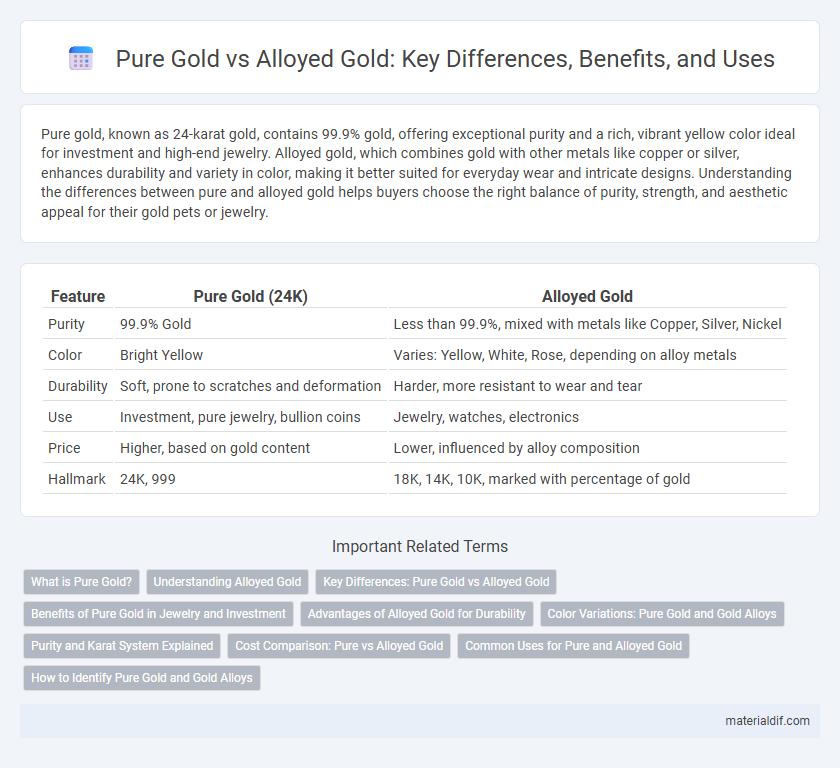Pure gold, known as 24-karat gold, contains 99.9% gold, offering exceptional purity and a rich, vibrant yellow color ideal for investment and high-end jewelry. Alloyed gold, which combines gold with other metals like copper or silver, enhances durability and variety in color, making it better suited for everyday wear and intricate designs. Understanding the differences between pure and alloyed gold helps buyers choose the right balance of purity, strength, and aesthetic appeal for their gold pets or jewelry.
Table of Comparison
| Feature | Pure Gold (24K) | Alloyed Gold |
|---|---|---|
| Purity | 99.9% Gold | Less than 99.9%, mixed with metals like Copper, Silver, Nickel |
| Color | Bright Yellow | Varies: Yellow, White, Rose, depending on alloy metals |
| Durability | Soft, prone to scratches and deformation | Harder, more resistant to wear and tear |
| Use | Investment, pure jewelry, bullion coins | Jewelry, watches, electronics |
| Price | Higher, based on gold content | Lower, influenced by alloy composition |
| Hallmark | 24K, 999 | 18K, 14K, 10K, marked with percentage of gold |
What is Pure Gold?
Pure gold, also known as 24-karat gold, consists of 99.9% gold without any other metals or impurities, making it the most valuable and naturally lustrous form of gold. It is soft and malleable, which limits its use in jewelry and industrial applications where durability and strength are required. To increase hardness and wear resistance, pure gold is often alloyed with metals like silver, copper, or zinc, resulting in lower karat gold such as 18K or 14K gold.
Understanding Alloyed Gold
Alloyed gold consists of pure gold combined with other metals such as copper, silver, or zinc to enhance durability and alter color, making it more suitable for jewelry and industrial applications. The karat system measures the purity of gold alloys, with 24 karats representing pure gold and lower karats indicating increased alloy content. Understanding the composition of alloyed gold helps determine its strength, color variations like rose or white gold, and overall value.
Key Differences: Pure Gold vs Alloyed Gold
Pure gold consists of 99.9% gold content, offering maximum purity and a distinct bright yellow color but is softer and more prone to scratching and bending. Alloyed gold combines pure gold with metals such as copper, silver, or zinc to enhance durability, strength, and color variety, typically measured in karats like 18K or 14K. The primary difference lies in purity and hardness, with pure gold prized for investment and purity, while alloyed gold is favored in jewelry for its practicality and resistance to wear.
Benefits of Pure Gold in Jewelry and Investment
Pure gold, composed of 24 karats, offers unmatched value in both jewelry and investment due to its high purity and resistance to tarnish or corrosion. Its hypoallergenic properties make it ideal for sensitive skin, while its consistent weight and intrinsic value provide reliable liquidity in global markets. Investors and collectors favor pure gold for its enduring worth, ease of valuation, and status as a universal store of wealth.
Advantages of Alloyed Gold for Durability
Alloyed gold, typically composed of gold mixed with metals like copper, silver, or nickel, offers significantly enhanced durability compared to pure gold, which is 24 karats and much softer. The added metals increase hardness and resistance to scratches, making alloyed gold ideal for everyday wear and intricate designs. This improved strength ensures longer-lasting jewelry and reduced maintenance, especially in rings and bracelets subject to frequent contact.
Color Variations: Pure Gold and Gold Alloys
Pure gold, composed of 24 karats, exhibits a distinct rich yellow color that remains consistent due to its unalloyed state. Gold alloys, created by mixing pure gold with metals such as copper, silver, or zinc, result in a wide range of color variations including rose gold, white gold, and green gold. These color shifts depend on the type and proportion of the alloying metals, offering versatility in jewelry design while maintaining the fundamental properties of gold.
Purity and Karat System Explained
Pure gold is composed of 24 karats, representing 99.9% gold content, while alloyed gold combines gold with other metals to enhance durability and alter color. The karat system measures gold purity on a scale from 1 to 24, where each karat denotes approximately 4.17% gold by weight. Jewelry labeled as 18K contains 75% gold, balancing value and strength for everyday wear.
Cost Comparison: Pure vs Alloyed Gold
Pure gold, known as 24 karat, commands a higher price due to its nearly 100% gold content and exceptional purity. Alloyed gold, such as 18 karat or 14 karat, contains a mixture of gold and other metals, resulting in lower cost and increased durability. The price difference is significant because pure gold's softness limits its use in everyday jewelry, while alloyed gold offers a more affordable and practical alternative.
Common Uses for Pure and Alloyed Gold
Pure gold, composed of 24 karats, is primarily used in high-value applications such as investment bullion, luxury jewelry, and electronic components due to its excellent conductivity and resistance to corrosion. Alloyed gold, combined with metals like copper, silver, or nickel, is commonly used in everyday jewelry, coins, and dental restorations because it offers increased hardness and durability while retaining the desirable properties of gold. The selection between pure and alloyed gold depends on the balance required between purity and mechanical strength for specific industrial or decorative purposes.
How to Identify Pure Gold and Gold Alloys
Pure gold, also known as 24 karat gold, is identified by its distinct bright yellow color and high malleability, while gold alloys contain other metals that alter both color and hardness. Testing methods such as acid testing, electronic gold testers, and X-ray fluorescence (XRF) analyzers provide accurate identification of gold purity. Visual indicators include hallmark stamps like 24K or 999 for pure gold and mixed karat markings such as 18K or 14K for gold alloys.
Pure Gold vs Alloyed Gold Infographic

 materialdif.com
materialdif.com